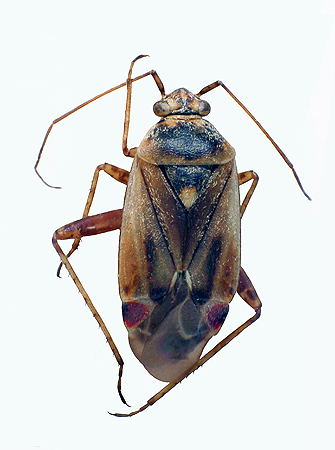Pests
Polymerus (Poeciloscytus) cognatus Fieb. - Beet Caspid Bug
Systematic position.
Class Insecta, order Hemiptera, family Miridae, genus Polymerus.Biological group.
This is a polyphagous pest of legumes, goosefoots, crucifers.Morphology and biology.
This bug is black or black-brown, pale-greenish in places, covered with silvery-white, easily falling scales (body length is 3.5-4.6 mm). Antenna are black-brown, its second segment light at apex. Hind margin of pronotum is light, its anterior corners below with glabrous velvety-black spot. Larvae are yellowish-green; older larvae often dark-green, covered with sparse black hairs. Head and thorax do not have distinct dark spots dorsally; femora and tibiae monochrome, without dark bands. Eggs are white or yellowish, without reticulation on chorion, 0.9-1.0 mm long. Eggs over-winter. Females lay wintering eggs on perennial forage legumes (alfalfa, sainfoin, clover) mainly. They place eggs into thin non-coarsened branchlets, small stems, leaf petioles of legumes and various weed plants. Development of embryos begins in autumn, but is interrupted when there is a cold snap. Development of larvae of 1st generation lasts about one month on the average. They spend most of their life in the lower and middle parts of plants. Development of larvae of 2nd generation does not exceed 20-30 days.Distribution.
The species inhabits middle and southern Europe, Northern Africa, Turkey, Mongolia and China. In the former USSR it is distributed in the European part southward of Latvia, in the Caucasus, Ural, Siberia, and the Far East (Amur Region, Khabarovsk and Primorskii Territories), in Central Asia and Kazakhstan.Ecology.
There are two generations in the forest-steppe zone, three in the south of Ukraine and in the Lower Volga Region, up to 4 generations in Central Asia and steppes of Ciscaucasia. Quick drying of the ground surface in spring with dry winds and the absence of precipitation can considerably lower larva hatching, causing their destruction within eggs, especially in open places. Hatching of larvae of the 1st generation occurs in the beginning of April (Ciscaucasia), at the end of April or in the beginning of May (Forest-steppe of Ukraine), in the beginning or middle of May (Voronezh Region, Altai Territory). Their development finishes with the beginning of flowering in forage legumes and grasses. Mass flight of bugs usually occurs during the last 3rd of May, coinciding with the mowing of leguminous forages for hay (Forest-steppe of Ukraine). Females migrate after harvesting to other fields at a distance of 3-4 km prior to oviposition. Most bugs of the 2nd generation develop on plantations of sugar beet, the rest develop on weed vegetation, buckwheat, vetch, oil-bearing crops (rape, false flax, sunflower), sometimes on potato and various garden, volatile-oil-bearing plants. Optimum humidity for development of larvae and imagoes is 30-70%. In the southern part of the species area the bugs of the 2nd generation make long distance migrations during the period of active flight in search of more suitable plants for feeding, populating new stations; their fertility is sharply reduced. Larvae of 3rd generation develop on late weed vegetation (saltwort, pigweed, goose-foot, etc.) in addition to irrigable leguminous forage in the south of Ukraine and in Ciscaucasia; quite often the weeds are almost uniquely suitable food for bugs along with halophytic vegetation of sea coasts and salty estuaries. In areas with 2 generations (forest-steppes) autumn conditions of their feeding are often favorable due to the abundance of young and juicy plants on fallows and stubble-fields of alfalfa, sainfoin, and clover. Females lay wintering eggs from August until mid-October (Poltava Region). In the south of the Ukraine and in Ciscaucasia females prefer to lay eggs on saltwort, frost-blite and amaranth. These eggs are resistant to adverse external conditions; their death rate does not exceed 5-8% during winter.Economic significance.
The pest often strongly damages legumes (alfalfa, sainfoin, and clover, less often vetch, melilot, soya, etc.), industrial crops (beet, ambary, jute, sesame, mustard, less often hemp, rape, melilot, sunflower, safflower, cotton, potato, etc.) and many garden crops. It is a polyphage, but in nature it obviously prefers Chenopodiaceae mainly, partly crucifers and wormwoods. It is an inhabitant of open spaces, occurring on glades, water-meadow, and other similar biotopes. The species seldom grows among wood plantings. It occupies abandoned and fallow lands, weedy grain crops, missing plots on winter crops, hay-stacking places, margins of field roads and forest belts, in addition to perennial leguminous pasture areas.Control measures.
Agronomical measures include spatial isolation of fields of perennial forage legumes seeded in different years due to crop rotation, at a distance of at least 0.5-1 km (optimum 1-1.5 km), mowing of grasses for hay in dry and hot weather prior to the appearance of insects, correct harvesting for hay or seeds, destruction of wintering eggs by low cutting with subsequent harrowing and burning of residues, autumn destruction of weeds. Chemical measures include the application of insecticides at the beginning of budding of leguminous crops against larvae of middle instars; on sugar beet plantations during the migration of bugs of 1st or 2nd generations.Reference citations:
Puchkov V.G. 1966. Main Miridae - agricultural pests. Kiev: Naukova dumka. 71 p. (In Russian)Puchkov V.G. 1972. Hemiptera (Heteroptera). In: Kryzhanovskii O.L., Dantsig E.M., eds. Insects and mites - pests of agricultural plants. V. 1. Primitive insects. Leningrad: Nauka. 222-262 p. (In Russian)
Puchkov V.G. 1973. Miridae. In: Vasil.ev V.P., ed. Pests of agricultural crops and forest plantations. V. 1. Kiev: Urozhai. 324-337 p. (In Russian)


